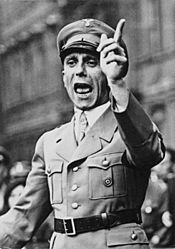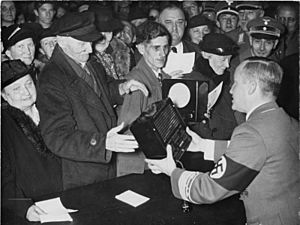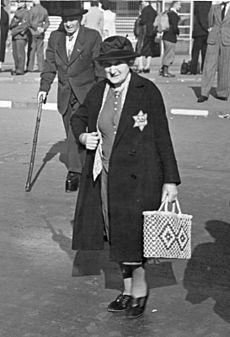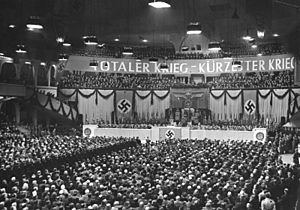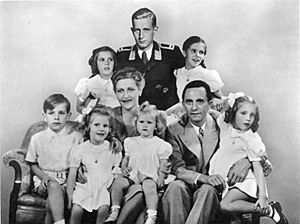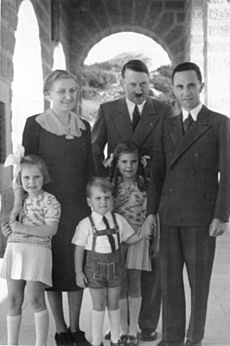Joseph Goebbels facts for kids
Quick facts for kids
Joseph Goebbels
|
|
|---|---|

Portrait by Heinrich Hoffmann
|
|
| Chancellor of Germany | |
| In office 30 April 1945 – 1 May 1945 |
|
| President | Karl Dönitz |
| Preceded by | Adolf Hitler |
| Succeeded by | Lutz Schwerin von Krosigk (as Leading Minister) |
| Reich Plenipotentiary for the Total War Effort | |
| In office 23 July 1944 – 1 May 1945 |
|
| Chancellor | Adolf Hitler (1934–45) |
| Preceded by | Office established |
| Succeeded by | Office abolished |
| Reichsminister of Public Enlightenment and Propaganda | |
| In office 14 March 1933 – 30 April 1945 |
|
| Chancellor | Adolf Hitler |
| Preceded by | Office established |
| Succeeded by | Werner Naumann |
| Stadtpräsident of Berlin | |
| In office 1 April 1943 – 1 May 1945 |
|
| Preceded by | Ludwig Steeg |
| Succeeded by | Office abolished |
| Reichsleiter | |
| In office 2 June 1933 – 1 May 1945 |
|
| Führer | Adolf Hitler |
| Gauleiter of Berlin | |
| In office 26 October 1926 – 1 May 1945 |
|
| Führer | Adolf Hitler |
| Preceded by | Ernst Schlange |
| Succeeded by | Office abolished |
| Personal details | |
| Born |
Paul Joseph Goebbels
29 October 1897 Rheydt, Kingdom of Prussia, German Empire (now Germany) |
| Died | 1 May 1945 (aged 47) Berlin, Nazi Germany |
| Political party | Nazi Party (1924–1945) |
| Spouse | |
| Children | Goebbels children |
| Alma mater |
|
| Occupation |
|
| Signature | |
| Formally titled "Leading Minister" or "Chief Minister" (Leitender Minister) | |
Paul Joseph Goebbels (29 October 1897 – 1 May 1945) was a German Nazi politician. He was the Gauleiter (district leader) of Berlin and the main person in charge of propaganda for the Nazi Party. From 1933 to 1945, he served as the Reich Minister of Propaganda.
Goebbels was one of Adolf Hitler's closest and most loyal followers. He was known for his strong public speaking skills and his intense hatred of Jewish people, which he often spoke about publicly. He pushed for harsher rules against Jewish people, including their extermination during the Holocaust.
Goebbels wanted to be a writer. He earned a PhD in Philology (the study of language and literature) from the University of Heidelberg in 1921. He joined the Nazi Party in 1924. In 1926, he became the Gauleiter of Berlin. There, he became very interested in using propaganda to promote the party. After the Nazis came to power in 1933, Goebbels's Propaganda Ministry quickly took control of news, arts, and information in Nazi Germany. He was especially good at using new media like radio and film for propaganda.
In 1943, Goebbels urged Hitler to start "total war" measures. This meant closing non-essential businesses, having women join the workforce, and drafting men who were previously exempt into the military. Hitler made him the Reich Plenipotentiary for Total War in July 1944. Goebbels tried to increase the number of people working in arms factories and serving in the military, but his efforts were not very successful.
As the war ended and Nazi Germany faced defeat, Goebbels, his wife Magda Goebbels, and their Goebbels children moved into Hitler's underground bunker in Berlin in April 1945. Hitler died by suicide on April 30. According to Hitler's will, Goebbels became Chancellor of Germany for one day. The next day, Goebbels and his wife took their own lives.
Contents
Early Life and Education
Paul Joseph Goebbels was born on 29 October 1897 in Rheydt, an industrial town in Germany. His parents were Roman Catholics from humble backgrounds. His father was a factory clerk, and his mother had Dutch and German roots. Goebbels had five siblings.
As a child, Goebbels was often sick. He had a deformed right foot that turned inward, which was shorter and thicker than his left foot. He wore a metal brace and a special shoe and walked with a limp. Because of this, he was not allowed to join the military during World War I.
Goebbels finished high school in 1917 as the top student. His parents hoped he would become a Catholic priest, which he considered. He studied literature and history at several universities, including Bonn, Würzburg, Freiburg, and Munich. He received a scholarship for his studies. During this time, he began to move away from the church.
At the University of Heidelberg, Goebbels wrote his doctoral thesis on a 19th-century writer. He earned his PhD in 1921. After university, he worked as a private tutor and a journalist for a local newspaper. His writings at this time showed his growing antisemitism and dislike for modern culture. He also tried to become a published author, but his plays did not sell. He kept a diary throughout his life, which was an outlet for his writing.
Joining the Nazi Party
Goebbels first became interested in Adolf Hitler and Nazism in 1924. Hitler was on trial for treason after a failed attempt to seize power. This trial brought Hitler a lot of attention. Goebbels was drawn to the Nazi Party because of Hitler's strong personality and beliefs. He joined the party around this time.
Goebbels started working for Gregor Strasser, a Nazi organizer in northern Germany. He helped with their weekly newspaper and secretarial tasks. He also became a party speaker. In 1925, Goebbels became the business manager and editor of NS-Briefe, a journal for a group of northern German Nazi leaders. This group, including Goebbels, had more socialist ideas than Hitler's group in Munich.
Hitler saw Strasser's ideas as a threat to his power. He called a meeting in Bamberg in 1926, where he gave a long speech against Strasser's new plans. Hitler said that socialism was "a Jewish creation" and that a Nazi government would not take away private property. Goebbels was shocked by Hitler's words. He wrote in his diary that he no longer fully believed in Hitler.
However, after reading Hitler's book Mein Kampf, Goebbels started to agree with Hitler's ideas about "Jewish doctrine of Marxism". Hitler then arranged meetings with Goebbels and other leaders. Goebbels was very impressed by Hitler. He wrote in his diary: "I love him... He has thought through everything." He decided to give Hitler his complete loyalty. As a result, the northern Nazi group was disbanded, and Hitler's power as party leader grew stronger.
Propaganda in Berlin
Hitler invited Goebbels to speak at party meetings and the annual Party Congress in 1926. Goebbels helped plan the 1927 rally, which was filmed for the first time. His success at these events made him admire Hitler even more.
Becoming Berlin's Nazi Leader
In August 1926, Goebbels was offered the job of party Gauleiter for Berlin. He accepted the position in October. Hitler gave Goebbels a lot of power over the Berlin area. Goebbels controlled the local Sturmabteilung (SA) and Schutzstaffel (SS) and reported only to Hitler.
When Goebbels arrived, the party had about 1,000 members in Berlin. He reduced this to 600 active members. To raise money, he started membership fees and charged admission to meetings. He knew that publicity, even bad publicity, was useful. He purposely caused fights at beer halls and street brawls, including attacks on the Communist Party of Germany. Goebbels used new advertising ideas for politics, like catchy slogans. His new poster designs used large red type and mysterious headlines to make people read the small print.
Goebbels practiced his public speaking in front of a mirror. Meetings started with marches and singing, and the venues were decorated with party banners. He usually arrived late for a dramatic effect. Goebbels planned his speeches carefully, using specific voice tones and hand gestures. He was also good at speaking without a script and connecting with his audience. He used loudspeakers, decorative flames, uniforms, and marches to draw attention to his speeches.
Because of the violence at Nazi Party events, the Berlin police banned the party from the city in May 1927. Goebbels was also banned from public speaking for a few months. During this time, he started the newspaper Der Angriff (The Attack) to spread Nazi ideas in Berlin. The paper was aggressive and highly anti-communist and antisemitic. It often attacked Bernhard Weiß, a Jewish police chief, calling him "Isidore" and trying to provoke him.
Elections and Growth
The ban on the Nazi Party was lifted before the Reichstag elections in May 1928. The Nazi Party only got 2.6 percent of the votes nationwide and 1.4 percent in Berlin. Goebbels was one of the first 12 Nazi Party members elected to the Reichstag. This gave him immunity from many legal charges. He continued to be elected in all future elections.
In 1930, violence between Nazis and communists in Berlin led to the death of SA leader Horst Wessel. Goebbels used Wessel's death to make him a hero for the Nazi movement. He made Wessel's march, Die Fahne hoch (Raise the flag), the official Nazi Party anthem, renamed the Horst-Wessel-Lied.
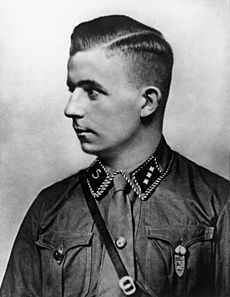
The Great Depression caused a huge increase in unemployment in Germany. In April 1930, Hitler appointed Goebbels as the national leader of Nazi Party propaganda. Goebbels took control of other Nazi newspapers, including the party's main paper, the Völkischer Beobachter (People's Observer).
Goebbels led the Nazi Party's national campaign for the Reichstag elections in September 1930. Thousands of meetings and speeches were held. Hitler blamed Germany's economic problems on the Weimar Republic and the Treaty of Versailles. He proposed a new German society based on race and national unity. The party won 6.5 million votes and 107 seats, becoming the second largest party.

In late 1930, Goebbels met Magda Quandt, a divorced woman who had joined the party. They married on 19 December 1931, with Hitler as Goebbels's best man.
For the 1932 elections, Goebbels organized huge campaigns, including rallies and parades. Hitler traveled by plane, using the slogan "the Führer over Germany." Goebbels wrote in his diary that the Nazis must gain power and destroy Marxism. He published speeches as records and pamphlets. Many of Goebbels's campaign posters used strong images, showing a giant man destroying political opponents. His propaganda called opponents "November criminals" or a communist threat.
On 30 January 1933, Hitler was appointed Reich Chancellor. Goebbels organized a torchlight parade in Berlin with 60,000 men to celebrate. Goebbels was disappointed not to get a cabinet position at first. The Nazis used the Reichstag fire of 27 February 1933 to pass laws that ended democracy in Germany. On 14 March, Goebbels finally became the head of the new Reich Ministry of Public Enlightenment and Propaganda.
The new ministry's goal was to centralize Nazi control over all German culture and intellectual life. Goebbels wanted to increase support for the party to 100 percent. He also wanted to show other countries that the Nazi Party had the full support of the German people. One of his first acts was to stage the Day of Potsdam, a ceremony where power was passed from President Hindenburg to Hitler. He also helped write Hitler's order for the Nazi boycott of Jewish businesses on 1 April.
Goebbels changed the 1 May holiday from a celebration of workers' rights into a day celebrating the Nazi Party. He organized a huge rally in Berlin. The next day, all trade unions were forcibly closed, and the Nazi-run German Labour Front was created. Less than two weeks later, Goebbels gave a speech at the Nazi book burning in Berlin on 10 May, an event he suggested.
The Nazi Party began passing laws to remove Jewish people from German society. The Law for the Restoration of the Professional Civil Service forced non-Aryans to retire from legal and civil service jobs. The first Nazi concentration camps were created to hold political opponents. The Nazis rapidly took control of all parts of life in Germany, a process called Gleichschaltung (co-ordination). By June 1933, almost all organizations were controlled by the Nazi Party. On 2 June 1933, Hitler made Goebbels a Reichsleiter, the second highest political rank in the party.
In October 1933, the Schriftleitergesetz (Editor's Law) was passed. This law gave the Nazi Party control over the press. Journalists had to "regulate their work in accordance with National Socialism." This law helped the Nazis control public opinion.
In June 1934, many opponents of the regime were arrested and killed in a purge known as the Night of the Long Knives. Goebbels was present at the arrest of SA leader Ernst Röhm. On 2 August 1934, President von Hindenburg died. Goebbels announced on the radio that Hitler had combined the offices of president and chancellor, becoming Führer und Reichskanzler (leader and chancellor).
How the Ministry Worked
The propaganda ministry had seven departments, covering areas like administration, rallies, radio, press, films, arts, and protection against counter-propaganda. Goebbels was a difficult boss, often changing his mind and criticizing his staff in public. However, he was very good at his job.
The Reich Film Chamber was created in June 1933, and all film industry members had to join it. Goebbels promoted films with Nazi messages. He also created the Reichskulturkammer (Reich Chamber of Culture) in September, which had sub-chambers for broadcasting, arts, literature, music, press, and theatre. Anyone wanting to work in these fields had to be a member. This allowed the regime to stop anyone with opposing views from working. Journalists had to prove their "Aryan" background. Many German artists and thinkers left Germany rather than work under these rules.
Goebbels was especially interested in controlling the radio, which was a new mass medium. He gained control of radio stations nationwide and put them under the Reichs-Rundfunk-Gesellschaft (German National Broadcasting Corporation) in July 1934. Goebbels encouraged manufacturers to make cheap radios called Volksempfänger (people's receiver). By 1938, nearly ten million had been sold. Loudspeakers were placed in public areas, factories, and schools so that almost all Germans could hear important party broadcasts live. After the war started, Goebbels made it illegal to listen to foreign radio stations. Sharing news from foreign broadcasts could lead to the death penalty.
A main focus of Nazi propaganda was Hitler himself. He was presented as a heroic and perfect leader, becoming the center of a cult of personality. Goebbels carefully planned events like the 1934 Nuremberg Rally to glorify Hitler. The rally was featured in the film Triumph of the Will, a Nazi propaganda film directed by Leni Riefenstahl.
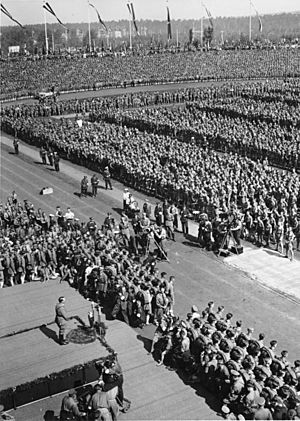
Goebbels also helped plan the 1936 Summer Olympics in Berlin. In 1937, he organized the Degenerate Art Exhibition in Munich, which was very popular. A similar exhibition for music took place the next year.
Persecution of Churches
In 1933, Hitler signed the Reichskonkordat (Reich Concordat) with the Vatican. This treaty stated that the regime would respect Catholic institutions and that clergy would not be involved in politics. However, the regime still tried to weaken the influence of Christian churches. In 1935 and 1936, hundreds of clergy and nuns were arrested, often on false charges. Goebbels used these trials in his propaganda campaigns to make the church look bad. Restrictions were placed on public meetings, and Catholic publications were censored. Catholic schools had to reduce religious teaching, and crucifixes were removed from state buildings.
In response, Pope Pius XI had an encyclical (a letter from the Pope) called "Mit brennender Sorge" ("With Burning Concern") secretly brought into Germany in 1937. It was read in every Catholic church and criticized the regime's hostility toward the church. Goebbels responded by increasing the crackdown and propaganda against Catholics. His speech on 28 May in Berlin attacked the Catholic church as morally corrupt. As a result, enrollment in religious schools dropped, and by 1939, all such schools were closed or converted to public ones.
Antisemitism and the Holocaust
Goebbels was antisemitic from a young age. After joining the Nazi Party, his hatred of Jewish people grew stronger. He saw them as a destructive force in German society. After the Nazis took power, he often urged Hitler to act against Jewish people. He actively promoted their persecution through propaganda, laws, and other actions. In Berlin, he banned Jewish people from public transport and required Jewish shops to be marked.
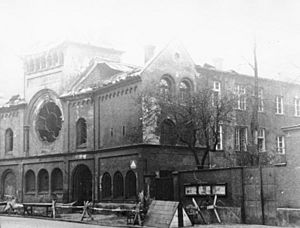
In November 1938, a German diplomat was killed in Paris by a young Jewish man. Goebbels used this event to create strong antisemitic propaganda, which led to a violent attack on Jewish people called Kristallnacht (Night of Broken Glass). Jewish people were attacked, synagogues were destroyed, and thousands of Jewish shops were vandalized across Germany. At least a hundred Jewish people were killed, and about 30,000 Jewish men were sent to concentration camps.
Goebbels continued his intense antisemitic propaganda. He helped write Hitler's speech on 30 January 1939, which warned that if "international finance Jewry" caused another world war, the result would be "the annihilation of the Jewish race in Europe!"
Deportations of German Jews began in October 1941. Goebbels ordered that all German Jews wear an identifying yellow badge starting 5 September 1941. In March 1942, Goebbels received a copy of the minutes from the Wannsee Conference. This document showed that the Jewish population of Europe was to be sent to extermination camps and killed. His diary entries show he was fully aware of the fate of Jewish people and supported it. He was one of the few top Nazi officials to publicly support the extermination of Jewish people.
World War II and Total War
As early as 1933, Hitler planned to rearm Germany, even though it violated the Versailles Treaty. Goebbels was a strong supporter of Hitler's aggressive expansion plans. He believed that "Fortune favors the brave!" and that Germany should act boldly. Before the Sudetenland crisis in 1938, Goebbels used propaganda to gain sympathy for Germans living in the Sudetenland and to campaign against the Czech government.
After the invasion of Poland in September 1939, Goebbels used his ministry to control information in Germany. He did not participate in military decisions or diplomatic talks until after they happened.
The Propaganda Ministry took over broadcasting in conquered countries immediately. They used existing announcers to gain trust. Goebbels controlled most media, both in Germany and in occupied areas. Party rallies, speeches, and demonstrations continued. Speeches were broadcast on the radio, and short propaganda films were shown using mobile film vans. As the war went on, Hitler made fewer public appearances, so Goebbels became the main voice of the Nazi regime for the German people. He wrote frequent articles that were read aloud on the radio. He found films to be his most effective propaganda tool after radio.
Goebbels focused on public morale and the efforts of people at home. He believed that the more people were involved in the war, the better their morale would be. For example, he started a program to collect winter clothing for troops on the eastern front. He also made sure that radio and film produced more "entertaining material" for the public.
By early 1943, the war caused a labor shortage. Goebbels pushed Hitler to introduce "total war" measures. This included closing non-essential businesses, drafting women into the workforce, and enlisting men from previously exempt jobs into the military. His famous Sportpalast speech on 18 February 1943 was a passionate call for Germans to commit to total war. He presented it as the only way to stop the "Bolshevik" attack and save the German people. The speech also had a strong antisemitic message.
Goebbels's efforts had little immediate impact because Hitler was not ready to make changes that his ministers opposed. Goebbels also used the discovery of a mass grave of Polish officers killed by the Red Army in the Katyn massacre to create propaganda. He hoped this would create a division between the Soviets and the Western Allies.
Plenipotentiary for Total War
On 1 April 1943, Goebbels became Stadtpräsident of Berlin, combining the city's top party and government roles under his control. After the Allied invasions of Sicily and Italy, and the Soviet victory at the Battle of Kursk, Goebbels began to realize the war could not be won. He suggested to Hitler that Germany make peace with either the Soviets or Britain, but Hitler refused.
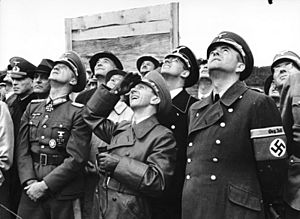
As Germany's situation worsened, Goebbels and Albert Speer continued to push Hitler for a total war economy. The 20 July Plot, where Hitler was almost killed, helped those pushing for change. On 23 July, Goebbels was appointed Reich Plenipotentiary for Total War. His job was to maximize manpower for the military and arms industry. He managed to free up half a million men for military service.
On 18 October 1944, Hitler ordered the formation of the Volkssturm (People's Storm). This was a nationwide militia of men previously considered unfit for military service. Goebbels noted that 100,000 recruits were sworn in from his area alone. However, these men, mostly aged 45 to 60, received little training and were poorly armed. Goebbels's idea that they could fight Soviet tanks was unrealistic. The program was very unpopular.
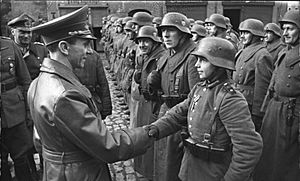
Goebbels realized his influence would decrease during wartime. Propaganda became less important than warfare and the war economy. His ministry was destroyed by an Allied air raid in March 1945. In April 1945, he finally took full charge of propaganda, but by then, the Soviet Red Army had already entered Berlin.
Defeat and Death
In the final months of the war, Goebbels's speeches and articles became very dramatic. By early 1945, with the Soviets approaching Berlin, he could no longer hide that Germany would lose. Berlin had few defenses, and even Volkssturm units were scarce. Goebbels noted in his diary that millions of Germans were fleeing westward. He discussed making peace with the Western Allies, but Hitler refused.
When other Nazi leaders urged Hitler to leave Berlin, Goebbels argued for a heroic last stand in the city. His family moved into their Berlin house to await the end. He knew how the world would view the regime's actions and did not want to face a trial. He burned his private papers on 18 April.
Goebbels encouraged Hitler to see the death of US President Franklin D. Roosevelt on 12 April as a sign of good fortune. By this time, Goebbels had gained the position he always wanted: at Hitler's side. Most of Hitler's inner circle prepared to leave Berlin after Hitler's birthday on 20 April. On 22 April, Hitler announced he would stay in Berlin until the end and then take his own life. Goebbels moved with his family into the Vorbunker, part of Hitler's bunker complex, that same day. He said he would not surrender or escape.
After midnight on 29 April, Hitler married Eva Braun in the bunker. Afterward, Hitler dictated his last will and testament. Goebbels and Martin Bormann were witnesses. In his will, Hitler named Goebbels as Reich Chancellor. Goebbels wrote a note saying he would "categorically refuse" to obey Hitler's order to leave Berlin. He felt he had to stay with Hitler "for reasons of humanity and personal loyalty." His wife and children would stay too.
In the afternoon of 30 April, Adolf Hitler died by suicide. Goebbels was very sad. He told Vice-Admiral Hans-Erich Voss that he would follow Hitler's example.
On 1 May, Goebbels performed his only official act as Chancellor. He wrote a letter to Soviet General Vasily Chuikov and ordered German General Hans Krebs to deliver it under a white flag. The letter informed Chuikov of Hitler's death and asked for a ceasefire. After this was rejected, Goebbels decided that further efforts were pointless.
Later on 1 May, Goebbels told Voss he would not leave his "sinking ship." He said he had nowhere to go with his small children and his leg. On the evening of 1 May, Goebbels arranged for an SS dentist to inject his six children with morphine. Once they were unconscious, a cyanide capsule was crushed in each of their mouths.
Around 8:30 PM, Goebbels and Magda left the bunker and walked to the Chancellery garden, where they took their own lives. Their remains were later burned and scattered into a river.
Family Life
Hitler was very fond of Magda Goebbels and her children. He enjoyed visiting their Berlin apartment. Magda had a close relationship with Hitler and became an unofficial representative of the regime, receiving letters from women across Germany about family matters.
The Goebbels family included Harald Quandt (Magda's son from her first marriage; born 1921), and their six children: Helga (1932), Hilde (1934), Helmuth (1935), Holde (1937), Hedda (1938), and Heide (1940). Harald was the only family member to survive the war. He died in an airplane crash in 1967.
See also
 In Spanish: Joseph Goebbels para niños
In Spanish: Joseph Goebbels para niños
- Glossary of Nazi Germany
- Gottbegnadeten list
- Hate media
- List of Nazi Party leaders and officials
- Nazi propaganda




